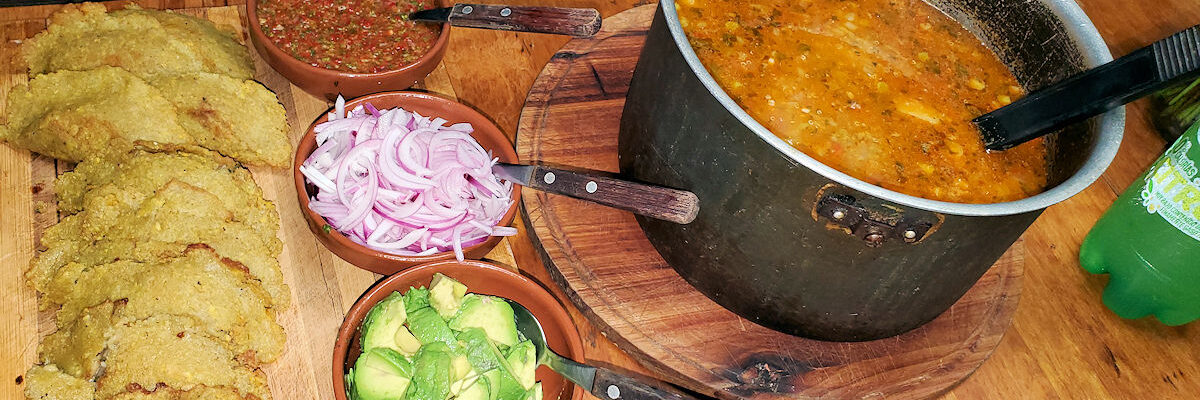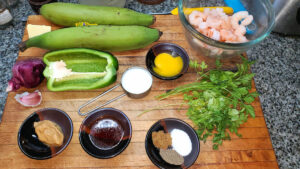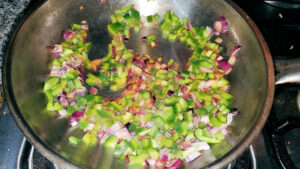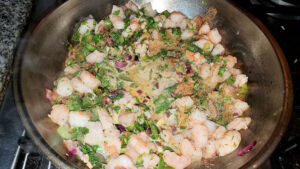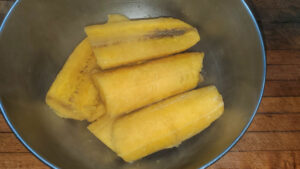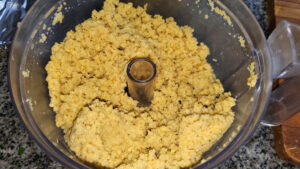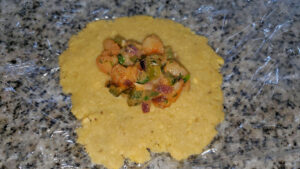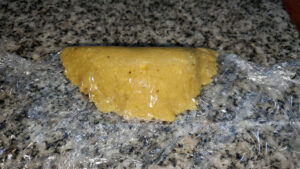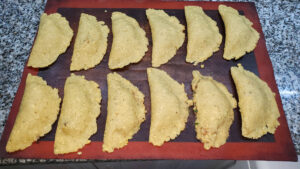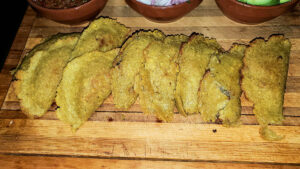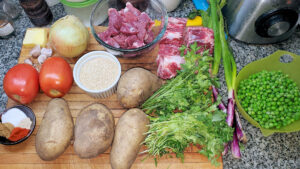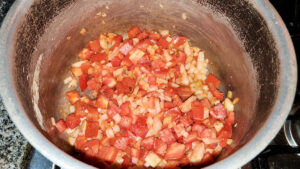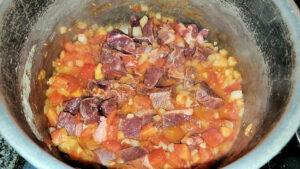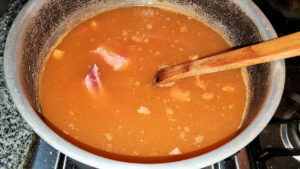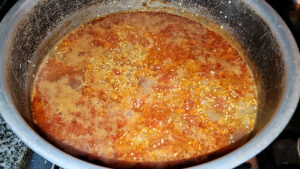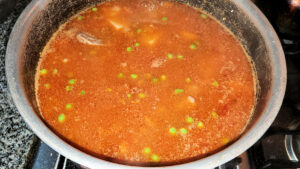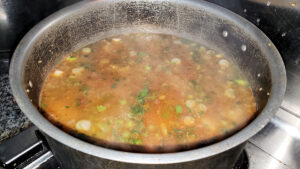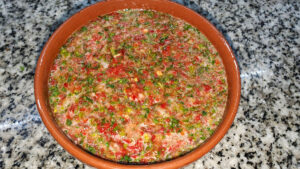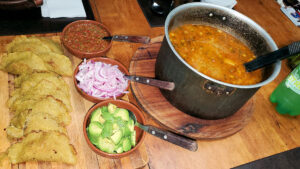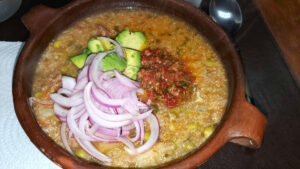Finally, on to a country and culture with which I have at least a vague familiarity. Not a lot, but at least more than some of the far flung places I’ve ventured to in the kitchen here. It’s been just over six years since our one trip to Quito, which is my only on the ground experience (check out the video on the linked post). But, I’ve at least experimented more with the cuisine here, and tasted dishes made by friends from there, than from many other spots.
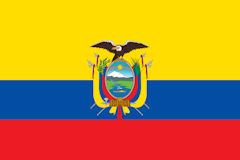 First, a brief look at the country, of course. It’s located in the northwest of South America, sandwiched between Colombia to the north and Peru to the south. First “organized” as an entity when absorbed into the Incan empire in the 15th century, it was then colonized by Spain in the 16th, becoming part of “Greater Colombia”, and then granted independence in 1830 – so it’s coming up on its bicentennial.
First, a brief look at the country, of course. It’s located in the northwest of South America, sandwiched between Colombia to the north and Peru to the south. First “organized” as an entity when absorbed into the Incan empire in the 15th century, it was then colonized by Spain in the 16th, becoming part of “Greater Colombia”, and then granted independence in 1830 – so it’s coming up on its bicentennial.
At 109,000 or so square miles, it falls in size between Nevada and Colorado, though with 18 million people, it’s far more populous than either. At the same time, that’s barely more people than live in the Buenos Aires metropolitan area (BA has a population density of 35,000/square mile, while Quito, Ecuador’s capital, barely edges towards 14,000). The population is almost entirely mestizo, a mix of indigenous and European backgrounds and cultures. The official language spoken is Spanish, though Quechua and Shuar are also considered official, and several other indigenous languages are recognized for certain purposes related to their communities.
The cuisine is fairly diverse, from a coastal seafood based one to farmlands to the mountains. For the purposes of this project, Ecuador is both heaven and hell – the country has been described as “the land of soups”, and food anthropologists peg the number of distinct soups throughout the country at almost 800. So there’s a plethora to choose from. At the same time, how to choose? The national soup is the locro de papas, a potato and dairy soup that’s one of my favorite potato soups of all time. But I’ve already covered that in my “L Word” project (I have too many projects, none of which are likely ever to be completed). In the end, I went with one that at least showed up multiple times in different online posts, and also was different from any of the soups I’ve done to date, Sopa de Quinua.
For the bread component, I went back to empanadas, and one of Ecuador’s “official” three types, the Empanada Verde. The other two, morocho and viento, respectively filled with purple corn and cheese fillings, are both sweet, served as snacks alongside coffee.
Let’s start with those empanadas. First off, why “verde”, or “green”? Not because the filling or dough is particularly green in color, though there’s a bit of the shade, but rather because the masa, the dough, is made from green plantains. And, for the dough we have those, plus egg yolk, milk, and butter, all towards the upper left of the photo. The filling is made from peeled and deveined shrimp, red onion, garlic, green bell pepper, cilantro, parsley, peanut butter, salt, pepper, cumin, and achiote (annatto) oil (very hard to find the achiote here, and several recipe writers recommended using a sweet paprika oil – just a small spoonful of paprika dissolved in neutral oil).
Sauté the onion, pepper, and garlic in the oil until soft.
Add the rest of the ingredients – the shrimp, spices, herbs, and peanut butter – and cook until the liquid has thickened up to a sort of creamy consistency, just a few minutes. Set aside to cool.
Peel the plantains and boil them in salted water until soft, about 20 minutes, though timing will depend on how green, i.e., unripe they are.
Now, traditionally, I’m sure, someone sits there and mashes the plantains to a pulp, but virtually everyone suggested just throwing them into the food processor and blitzing them to a sort of soft crumb. Leave to cool a bit, and then blend in the butter, milk, and egg yolk to get a soft dough the texture of modeling clay.
Press or roll out into rounds between sheets of plastic wrap, and then top with a heaping tablespoon of the filling. For the amount of dough I made, I ended up making a dozen empanadas. Each dough ball weighed in at about 40 grams.
Using the plastic wrap it’s sitting on, carefully fold the dough over and seal the empanada.
Ready for frying! Not all perfect by any stretch, but I’m getting better with this technique for non flour based doughs.
And, fry them up until golden brown on each side. Three of them ended up falling apart, but so be it.
On to the soup. We have a fair number of ingredients this time around. Butter, garlic, onion, cubed beef (I used a shoulder roast and cut it up), some beef bones, tomato, quinua, potatoes, cilantro, parsley, green onion, peas, salt, pepper, cumin, and paprika (probably achiote in original recipes – and this time I used smoked paprika, just to accent the beef).
Sauté the onion, garlic, tomato, and spices in the butter until cooked down and falling apart, about 10-15 minutes.
Add the beef and cook for another five minutes, stirring regularly.
Add the beef bones and water (about 2-1/2 liters here), bring to a boil, turn the heat down, and cook for thirty minutes.
Rinse the quinua well in a strainer, until the water runs clear. Quinua grains have a slightly bitter coating on them that can make dishes taste “off” if you don’t remove it. Cook for another 15-20 minutes.
Add the potatoes and peas and cook another thirty minutes.
At this point the quinua will have swollen up to about four times its original size, making for a nice thick soup, and the potatoes will be cooked through. Add the chopped herbs and green onion and you’re ready to serve.
The soup traditionally has three guarniciones, or garnishes, one of which is an Ecuadorian ajicito, or hot sauce. The food processor, actually, a stick blender this time, is perfect for getting a good consistency. It’s a mix of chilies, green onion, garlic, cilantro, lime juice, salt, and just enough water to get a “salsa” consistency. The other two guarniciones are cubes of avocado, and thin slivers of red onion that have been soaked for about fifteen minutes in salted water, then drained, and tossed with a pinch of salt, and splashes of olive oil and lime juice.
And, invite a couple of friends over, as we did, and serve it all up – soup, garnishes, and empanadas! Let people garnish to their own tastes.
The complete soup with garnishes.
We loved the soup and the empanadas. The latter will take some practice to get the dough right, but we finished them off in a couple of minutes. The soup is hearty and rich and really tasty – and the trio of garnishes really makes it “sing”. I’d happily make both of these again.
Next time, we head to the Middle East, and Egypt.
